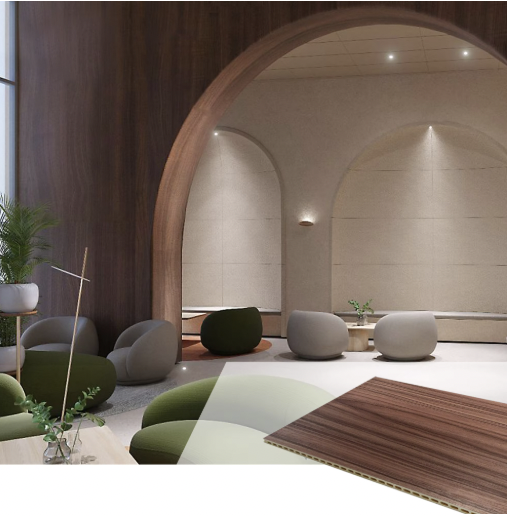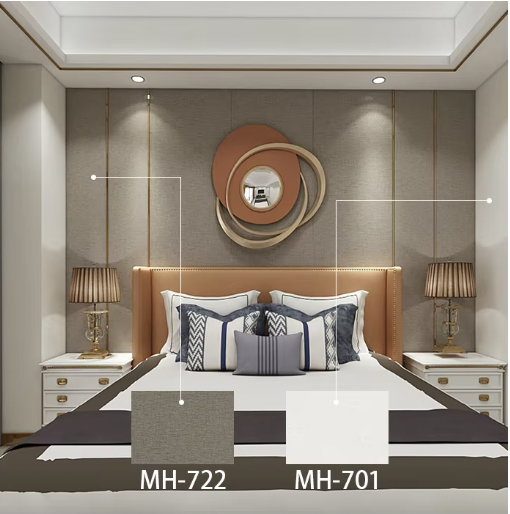Understanding Material Choices for Interior Flat Wall Panels
Eco-Friendly and Sustainable Material Options
Sustainable materials are making waves in interior design these days. Design professionals and property owners alike are turning to green alternatives like bamboo, old-growth wood that's been repurposed, and composite materials made from recycled content for their wall paneling needs. What makes these choices stand out isn't just their positive impact on the planet, but how they bring distinctive visual appeal to living spaces. The numbers back this up too. According to a Nielsen report, around two thirds of people worldwide actually pay extra when shopping for items labeled as eco-friendly. For those looking at material options, checking for labels from organizations such as FSC or GREENGUARD gives peace of mind regarding where things come from and how they were produced. Going with certified products boosts the overall green credentials of any space without compromising on quality standards or responsible spending habits.
Comparing Synthetic vs. Natural Compositions
Picking out materials for interior flat wall panels requires knowing what separates synthetics from naturals. Wood products like plywood bring that timeless look many people love, plus they feel warmer when touched. On the flip side, plastic-based options such as PVC last longer and need less cleaning overall. The price tag usually favors synthetic panels too, which tend to hold up better in busy spaces where walls get bumped regularly. Still worth noting though, some folks prefer going green with natural materials because they generally leave a smaller carbon footprint. Research shows that yes, PVC stands up to water damage much better than wood does, but manufacturing processes for synthetics typically create more pollution problems down the line. So when shopping around, think about where each material shines best depending on whether looks matter most or if sustainability ranks higher on the priority list.
High-Performance Composite Solutions
High performance composite materials are changing how we think about interior flat wall panels completely. These modern materials stand out because they last longer and resist water damage better than most alternatives, making them ideal for places where moisture is a problem, like bathrooms or kitchen spaces. They're also much lighter than traditional options which means installers don't struggle as much during installation, but still hold up against daily wear and tear pretty well. We've seen composite panels become increasingly popular lately according to market trends, probably because contractors and designers keep finding new ways to use them effectively. What really sets these panels apart though is that they maintain their good looks over time while performing reliably day after day, which explains why so many homeowners and business owners choose them when they want something both stylish and functional for their walls.
Design Flexibility and Aesthetic Impact
Creating Visual Depth Through Textured Finishes
When it comes to interior design, textured finishes really stand out as something special for transforming plain walls. Adding things like embossed patterns, shiplap boards, or classic wainscoting turns what was just an empty wall into something eye-catching that becomes part of the room's character. The way these textures catch and reflect light creates interesting shadows throughout the day, giving any space extra dimension. Take embossed designs for example they work wonders when placed where natural light hits them at certain angles, which makes rooms feel livelier and somehow more welcoming. Many professionals working in design point out how important texture is not just visually but emotionally too. A room with good texture tends to feel cozier and more comfortable overall, which matters a lot when trying to make people feel at home in a space.
Matte vs. Gloss: Curating Spatial Ambiance
Wall panel finishes matter a lot when it comes to how a space feels, mainly because they affect how light bounces around and sets the overall mood. Matte surfaces tend to soak up light, giving off a gentle, low key vibe that works great for making people feel relaxed. Glossy panels do the opposite though, bouncing light back out which makes rooms appear bigger and brighter. Most interior designers suggest going with glossy options in tight spaces where making things look roomier is important. For big open areas, matte finishes often hit the spot better since they help create that peaceful, laid back atmosphere everyone wants these days. Picking between them really depends on what the room needs to do and what kind of feeling we want to get across, all while keeping both looks good and practical considerations in mind.
Customization Strategies for Unique Design Themes
Bespoke Sizing and Modular Configuration
Interior design customization really matters when people want their space to look different from everyone else's. When furniture fits just right, rooms can change completely, working around odd corners and making everything feel connected instead of disjointed. Take modular panels as an example they're super adaptable because they're simple to put up yet flexible enough to reshape entire areas. Some systems let folks move panels around themselves, which means updating a room doesn't require tearing down walls or spending thousands on renovations. People definitely want this kind of flexibility these days. Research shows something like 7 out of 10 homeowners actually care about getting custom pieces that make their home stand out rather than settling for off-the-shelf solutions.
Color Matching for Cohesive Interior Narratives
Getting colors right matters a lot when creating interiors that tell a consistent story throughout the space. Everything needs to work together visually for the whole look to feel put together properly. Digital tools for matching colors have changed things quite a bit for interior designers lately. These apps let them get really accurate results that weren't possible before with just eyes alone. Some methods involve looking at light wavelengths to match shades exactly across different surfaces and fabrics. Many designers talk about how getting those color matches spot on makes all the difference in their projects. When rooms flow from one to another without jarring color shifts, clients tend to love the finished product much more. Take this real world scenario: an interior designer working on a client's home will probably use special software to copy the exact shade of a decorative wall panel onto cushions, curtains, and even furniture pieces so everything looks like it belongs together instead of feeling random.
Durability and Maintenance Requirements
Scratch-Resistant and UV-Stable Surfaces
Interior flat wall panels need to stand up to wear and tear, particularly where people move through constantly. High pressure laminates and ceramic coated panels tend to be go to choices because they resist scratches and hold up against UV exposure. Take ceramic coated glass panels for example Technical Glass Products did some testing showing these materials really handle scratches well, which explains why they show up so much in places like office buildings and schools. Keeping these surfaces looking good means regular cleaning but not anything harsh. Just grab a soft cloth and some gentle cleaner once in a while and those panels stay looking fresh without fading from sun exposure. Designers who want lasting results usually pick out scratch resistant options and follow basic care routines. Many panel makers suggest adding UV protection coatings every now and then, especially on walls facing windows or outdoor areas where sunlight hits directly.
Moisture Management in High-Humidity Zones
Moisture management matters a lot when picking out panels for bathrooms, kitchens, or any area where humidity tends to hang around. Look for materials that won't warp or grow mildew over time. Engineered woods with sealed cores work pretty well, as do composite panels. These options hold up against damp conditions while keeping their shape and strength. The CDC reports something shocking actually mold can spread at惊人的 speeds in places where water isn't properly managed, sometimes reaching 45% coverage within just seven days. That's why installing panels resistant to humidity makes sense for anyone concerned about safety and health issues. Good airflow helps too. Adding proper ventilation systems keeps humidity levels under control and stops damage from building up over years. Regular checks and maintenance shouldn't be overlooked either they catch small problems before they become big ones. When all these elements come together, rooms stay looking good longer and avoid structural issues down the road.

Functional Considerations for Modern Interiors
Acoustic Performance in Open-Plan Spaces
The way sound behaves matters a lot in today's open plan spaces. When there's no control over noise, it just bounces around everywhere, messing with what people are trying to do and making everyone feel exposed. That's why acoustic panels have become so popular lately. These panels come in various materials like mineral wool or special foam mixtures that actually soak up sound instead of letting it echo back at us. Putting them up makes a big difference in creating spaces where folks can actually focus without being bombarded by constant background chatter. We've seen this work wonders in offices where teams need concentration and even in apartments where neighbors might otherwise hear everything going on next door. A recent report from the Journal of the Acoustical Society of America found something pretty interesting too: workplaces that manage their sound properly see about a 15% boost in productivity simply because workers aren't constantly fighting against distracting noises anymore.
Integration With Smart Home Systems
Smart home tech combined with interior design, particularly wall panels, has really taken off lately. These panels work great with home automation setups and help cut down on energy bills while making life easier around the house. Wall panels now come packed with features such as automatic lights, voice activated helpers, and built-in temperature controls. All these extras let people tailor their space just how they want it without wasting power. According to research from NREL, homes equipped with smart systems might save about 30 percent on electricity costs. Beyond saving money though, this kind of tech fits right into today's green living movement and gives any space that contemporary, connected vibe most folks are after nowadays.
FAQ Section
What materials are considered eco-friendly for wall panels?
Sustainable materials such as bamboo, reclaimed wood, and recycled composites are considered eco-friendly choices for wall panels.
What are the benefits of high-performance composite wall panels?
High-performance composite wall panels are durable, moisture-resistant, lightweight, and versatile, making them ideal for challenging environments like bathrooms and kitchens.
How do matte and gloss finishes affect room ambiance?
Matte finishes create a soft and soothing atmosphere by absorbing light, while gloss finishes reflect light, making spaces feel larger and more vibrant.
How can customization enhance interior design?
Customization, such as bespoke sizing and modular configurations, allows for unique aesthetics, adapting to specific needs and irregular layouts.
What materials are best for moisture management in high-humidity areas?
Materials like engineered wood with moisture-sealed cores and composite panels resist warping and mildew, ideal for high-humidity areas like bathrooms and kitchens.

